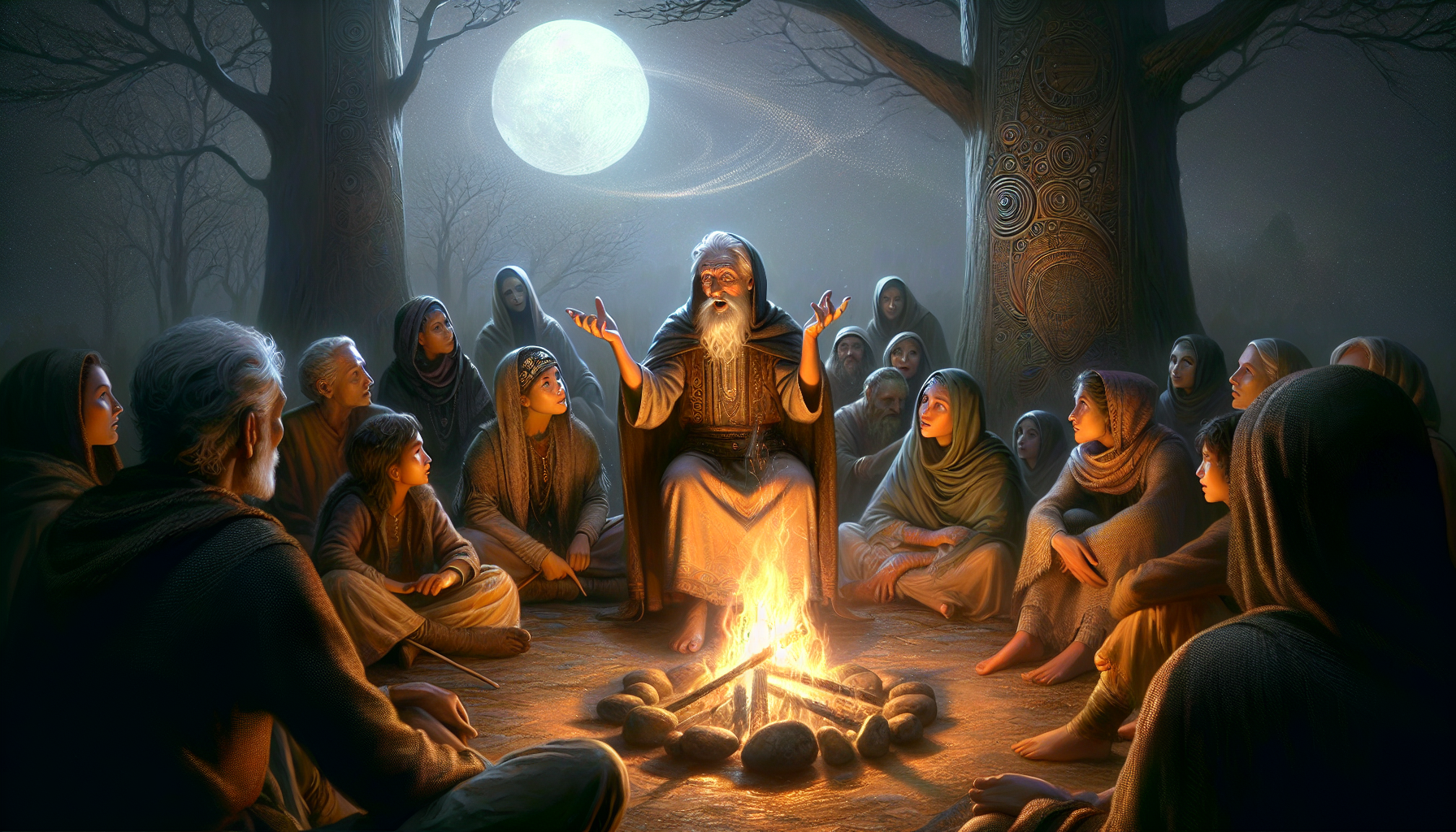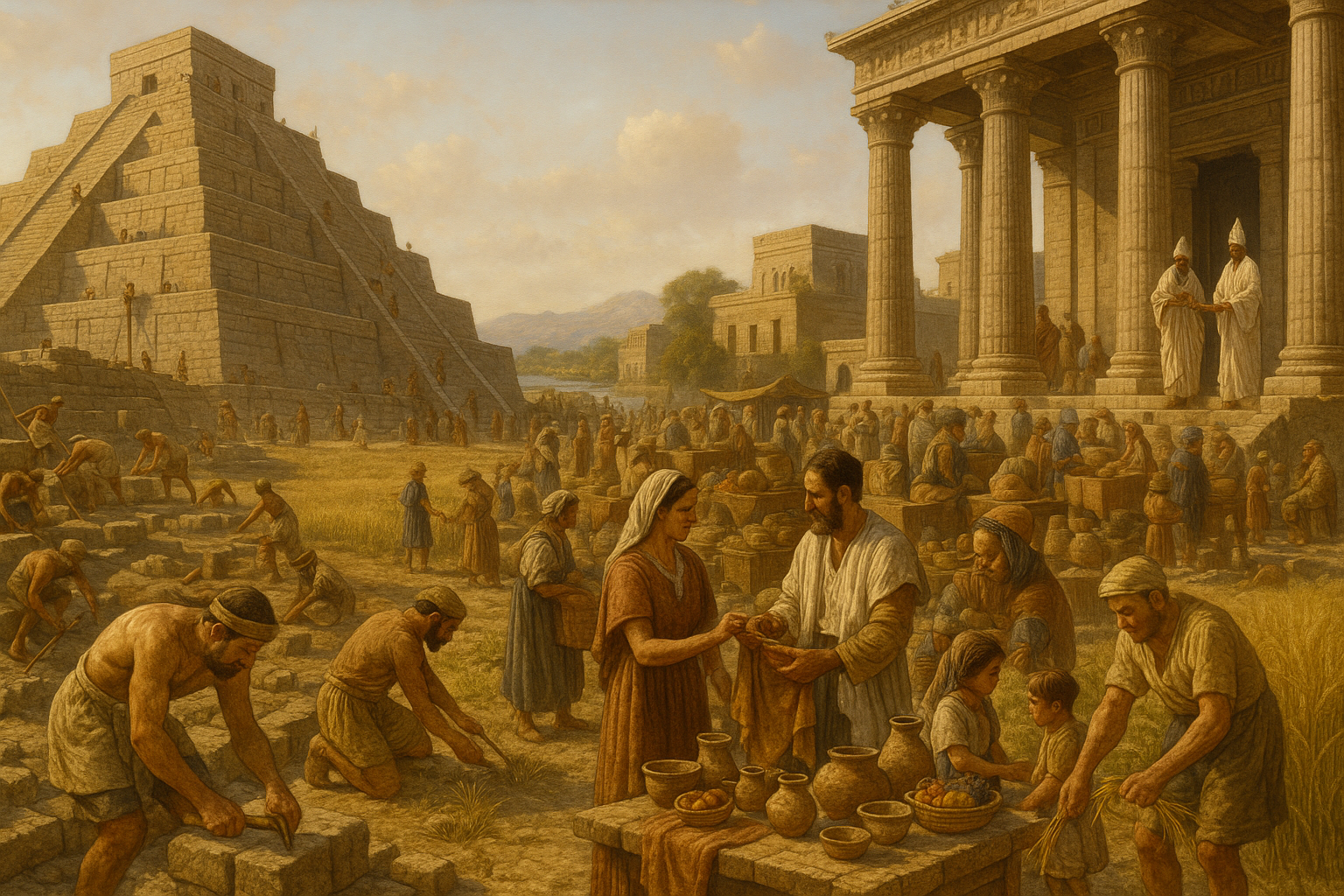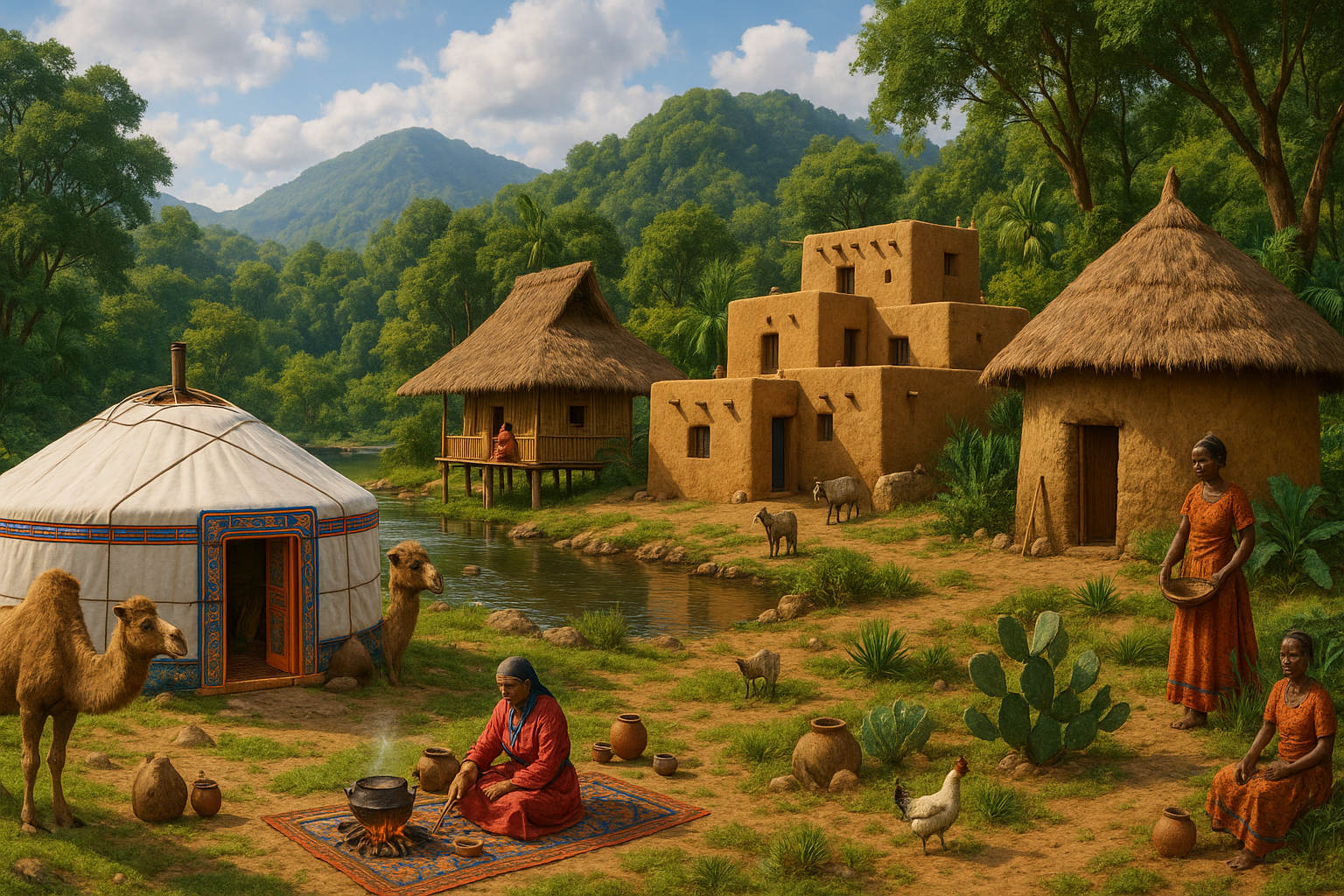In a world where information is often just a click away, it’s easy to overlook the rich tapestry of stories and knowledge that have been passed down through generations by word of mouth. Long before the advent of the written word, ancient civilizations relied on oral traditions to share their histories, myths, and legends. These stories, recounted with passion and precision around flickering campfires or within the protective walls of community gatherings, served as the backbone of cultural identity, connecting the past to the present and shaping the future. But what is it about oral tradition that has allowed it to endure through the ages, and why does it remain such a powerful tool for preserving the myths and legends that define us? 📖✨
At its core, oral tradition is an art form, a dynamic and interactive way of storytelling that evolves with each retelling. Unlike written texts, which are static and unchanging, oral narratives can adapt to the audience and the times, ensuring their relevance and resonance. This adaptability is one of the key strengths of oral tradition, allowing myths and legends to survive even in the face of cultural shifts and technological advancements. Through this fluid form of storytelling, communities not only preserve their heritage but also imbue it with contemporary meanings, keeping it alive and vibrant. As we delve into the intricacies of oral tradition, we’ll explore how this age-old practice continues to shape our understanding of the world and our place within it.
Moreover, oral tradition is inherently communal, fostering a sense of belonging and continuity. When stories are shared orally, they create a shared experience between the storyteller and the audience, bridging generational gaps and strengthening communal bonds. This communal aspect of oral tradition serves as a powerful tool for cultural preservation, ensuring that the collective memory of a people is passed down and that their unique perspectives are not lost to time. As we unravel the mysteries behind the enduring power of oral tradition, we will examine the role it plays in maintaining the cultural fabric of societies across the globe, from the epic tales of ancient Greece to the rich folklore of Indigenous peoples.
The Role of Oral Tradition in Cultural Preservation
Oral tradition is a powerful tool in preserving the rich tapestry of human culture, myths, and legends. It is a practice that dates back thousands of years, allowing societies to pass down knowledge, beliefs, and traditions without the written word. By sharing stories verbally from one generation to the next, communities maintain their cultural identity and heritage. This process not only preserves the stories themselves but also keeps the social fabric intact by fostering a sense of belonging and continuity.
Oral tradition plays a critical role in maintaining the authenticity of myths and legends. When stories are passed down orally, they are often told with a level of passion and detail that can be lost in written form. The storyteller becomes an artist, painting vivid pictures with words that captivate the audience, leaving lasting impressions that are remembered for generations. These oral narratives are dynamic, evolving with each telling, reflecting the changing values and beliefs of the community.
Table: Key Elements of Oral Tradition
| Element | Description |
|---|---|
| Storytelling | The art of conveying stories orally, often involving emotion and creativity. |
| Memory | The capacity to recall and accurately reproduce stories over time. |
| Adaptability | The ability to modify stories to reflect contemporary values and experiences. |
| Community | The collective engagement and participation in the storytelling process. |
For a deeper understanding, watch this insightful video: The Power of Oral Tradition – Storytelling Across Cultures (YouTube Channel). 📺
Impact of Oral Tradition on Identity and Community
Oral tradition is more than just a means of storytelling; it is an essential component of cultural identity and community cohesion. By sharing stories, people reinforce shared histories, beliefs, and values, which are critical for maintaining a cohesive cultural identity. This shared identity is vital for community resilience, especially in times of change or crisis.
The act of storytelling itself strengthens community bonds. When individuals gather to listen to a story, they engage in a communal experience that reinforces social ties. This interaction fosters a sense of belonging and mutual understanding among community members, creating a shared cultural consciousness that is passed down through generations.
Moreover, oral tradition plays a significant role in education and the transmission of knowledge. Stories often contain lessons and moral teachings that guide behavior and decision-making. By passing down these narratives, societies ensure that their members are equipped with the wisdom and values necessary to navigate their world. The storytelling process also encourages critical thinking and active listening, as audience members engage with the narrative and interpret its meaning within their own cultural context.
Benefits of Oral Tradition
- Preservation of cultural heritage and identity
- Strengthening of community bonds and social cohesion
- Transmission of knowledge and moral teachings
- Fostering of creativity and critical thinking
Challenges and Adaptations in Modern Times
In today’s fast-paced, technology-driven world, oral tradition faces numerous challenges. The dominance of digital media and written communication has led to a decline in oral storytelling practices. As a result, many traditional stories risk being lost or forgotten as younger generations become more disconnected from their cultural roots.
However, modern technology also offers new opportunities for the preservation and revitalization of oral tradition. Digital platforms and social media can serve as tools for sharing and recording stories, reaching wider audiences than ever before. By embracing these technologies, communities can adapt their oral traditions to contemporary contexts, ensuring their stories remain relevant and accessible.
Additionally, educational initiatives and cultural programs play a crucial role in revitalizing oral tradition. By incorporating storytelling into curricula and community events, these programs foster a renewed appreciation for the art of oral storytelling. They also provide platforms for elders and community leaders to share their stories, ensuring the continuation of this vital cultural practice.
Adaptation Strategies
- Utilizing digital media to record and share stories
- Incorporating oral tradition into educational programs
- Encouraging community events centered around storytelling
- Supporting initiatives that promote the preservation of cultural heritage
By embracing these strategies, societies can ensure that their oral traditions continue to thrive in the modern age, preserving the rich tapestry of human culture for future generations.

Conclusion
Unraveling the complexities surrounding oral tradition reveals its undeniable power in preserving the myths and legends that form the cultural backbone of societies worldwide. Throughout our exploration of this timeless form of storytelling, we have seen how oral tradition serves as a living repository of cultural heritage, a means of education, and a way to foster community and identity.
First, we delved into the historical significance of oral tradition, tracing its roots back to times when written language was either non-existent or inaccessible to the masses. Oral tradition was more than a necessity; it was an art form, a way for communities to pass down wisdom, morals, and entertainment from one generation to the next. We examined examples from diverse cultures, such as the griots of West Africa, who are not just storytellers but also historians, genealogists, and musicians, preserving the rich tapestry of their people’s past.
Moreover, we explored the elements that give oral tradition its enduring strength: memory, performance, and adaptability. Unlike written texts, oral stories are dynamic, allowing each storyteller to imbue them with personal flair while retaining the core message. This adaptability ensures the survival of myths and legends, allowing them to evolve with the times while maintaining their foundational truths.
Importantly, we discussed the role of oral tradition in preserving languages and dialects that might otherwise vanish. In many indigenous and marginalized communities, oral storytelling is a crucial component of linguistic heritage, keeping endangered languages alive in the hearts and minds of the people. This aspect is vital, as language is deeply intertwined with cultural identity.
In considering the educational aspect, we noted how oral tradition is used not just to entertain, but to teach. Stories serve as vehicles for imparting values, ethics, and lessons in a manner that is engaging and memorable. Through tales of heroes and cautionary tales, listeners—especially young ones—are invited to learn from the past and apply these lessons in their own lives.
The communal aspect of oral tradition also plays a crucial role in its power. By gathering communities to listen and engage with storytellers, these narratives help forge social bonds and a sense of belonging. In an age where digital communication often replaces face-to-face interactions, the communal experience of oral storytelling is more precious than ever.
Finally, we explored the challenges facing oral tradition in the modern world. With the rise of digital media, the written word, and audiovisual storytelling, oral tradition might seem at risk of obsolescence. Yet, there are movements and initiatives dedicated to revitalizing and preserving these traditions. From storytelling festivals to digital archives, people around the world are working to ensure these narratives continue to thrive.
The power of oral tradition in preserving myths and legends is as relevant today as it was centuries ago. By keeping these stories alive, we maintain a connection to our past, preserve cultural identities, and enrich our collective human experience. This article only scratches the surface, and there is so much more to learn and explore. 🌍
We encourage you, dear reader, to reflect on the stories that have shaped your own life. Consider sharing these tales with others, or perhaps seek out the myths and legends from other cultures to broaden your perspective. By doing so, you participate in a grand tradition that spans generations and continents.
If this topic resonates with you, consider leaving a comment or sharing this article with others who might find it interesting. Let’s keep the conversation going and ensure these vital traditions continue to inspire and educate future generations.
For those eager to delve deeper into this subject, here are some resources and organizations dedicated to the preservation and study of oral tradition:
– **The World Oral Literature Project**: A fascinating initiative aimed at documenting and preserving endangered oral literatures across the globe. [World Oral Literature Project](http://www.oralliterature.org)
– **Smithsonian Center for Folklife and Cultural Heritage**: Offers a wealth of resources on the importance of cultural traditions. [Smithsonian Folklife](https://folklife.si.edu)
We hope this exploration has ignited your interest in the rich tapestry of oral tradition. Let us celebrate and protect this powerful form of storytelling that binds us to our past and enriches our future. 🌟
Toni Santos is a visual storyteller and experimental artisan whose work explores the strange frontiers where science meets art. Fascinated by the forgotten, the obscure, and the wonderfully absurd, Toni brings bizarre scientific experiments to life through provocative visual narratives and handcrafted creations that blur the line between curiosity and discovery.
His journey is rooted in a passion for the eccentric side of science — from electric shocks on cadavers to botany in hostile environments, from Victorian medical oddities to animal behavior gone rogue. Each project Toni undertakes sheds light on real (and sometimes questionable) scientific ventures that push the boundaries of human understanding.
With a background in visual design and hands-on craftsmanship, Toni blends artistic precision with conceptual boldness. His creations aren’t just decorative — they provoke, disturb, and invite the viewer to reconsider what counts as science, progress, or even sanity. Often inspired by true experiments — like galvanic resurrection, psychological endurance tests, or 19th-century pseudo-science rituals — Toni’s work reanimates these bizarre chapters of history with aesthetic intrigue and critical reflection.
As the creative force behind Vizovex, Toni invites you to explore a world where the strange becomes symbolic, the grotesque becomes beautiful, and every experiment tells a story worth unearthing.
His work pays tribute to:
The brilliant madness of forgotten experiments
The symbolic power of science at the edge of reason
The beauty in questioning what we think we know
Whether you’re a curious mind, a lover of scientific history, or simply drawn to the uncanny, Toni welcomes you to explore a realm where aesthetics and absurdity collide — one experiment, one mystery, one creation at a time.





